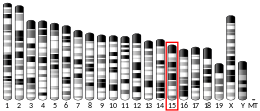TNRC6B
Trinucleotide repeat-containing gene 6B protein is a protein that in humans is encoded by the TNRC6B gene.[5]
Interactions
TNRC6B has been shown to interact with EIF2C2.[6] It is also known to associate with argonaute proteins and has been shown to be required for miRNA-guided gene silencing in HeLa cells.[7]
gollark: Great, that seems utterly usable for this.
gollark: I'm sure *somebody* on NPM has either a configurable/extensible DNS server package or a DNS wire format encoder/decoder.
gollark: Definitely, yes.
gollark: Thank you.
gollark: I am pinged MUCH less than 81.9% of the time.
References
- GRCh38: Ensembl release 89: ENSG00000100354 - Ensembl, May 2017
- GRCm38: Ensembl release 89: ENSMUSG00000047888 - Ensembl, May 2017
- "Human PubMed Reference:". National Center for Biotechnology Information, U.S. National Library of Medicine.
- "Mouse PubMed Reference:". National Center for Biotechnology Information, U.S. National Library of Medicine.
- "Entrez Gene: TNRC6B trinucleotide repeat containing 6B".
- Till S, Lejeune E, Thermann R, Bortfeld M, Hothorn M, Enderle D, Heinrich C, Hentze MW, Ladurner AG (October 2007). "A conserved motif in Argonaute-interacting proteins mediates functional interactions through the Argonaute PIWI domain". Nat. Struct. Mol. Biol. 14 (10): 897–903. doi:10.1038/nsmb1302. PMID 17891150.
- Meister G, Landthaler M, Peters L, Chen PY, Urlaub H, Lührmann R, Tuschl T (December 2005). "Identification of novel argonaute-associated proteins". Curr. Biol. 15 (23): 2149–55. doi:10.1016/j.cub.2005.10.048. PMID 16289642.
Further reading
- Nakajima D, Okazaki N, Yamakawa H, et al. (2003). "Construction of expression-ready cDNA clones for KIAA genes: manual curation of 330 KIAA cDNA clones". DNA Res. 9 (3): 99–106. doi:10.1093/dnares/9.3.99. PMID 12168954.
- Bonaldo MF, Lennon G, Soares MB (1997). "Normalization and subtraction: two approaches to facilitate gene discovery". Genome Res. 6 (9): 791–806. doi:10.1101/gr.6.9.791. PMID 8889548.
- Gubin AN, Njoroge JM, Bouffard GG, Miller JL (1999). "Gene expression in proliferating human erythroid cells" (PDF). Genomics. 59 (2): 168–77. doi:10.1006/geno.1999.5855. PMID 10409428.
- Kikuno R, Nagase T, Ishikawa K, et al. (1999). "Prediction of the coding sequences of unidentified human genes. XIV. The complete sequences of 100 new cDNA clones from brain which code for large proteins in vitro". DNA Res. 6 (3): 197–205. doi:10.1093/dnares/6.3.197. PMID 10470851.
- Dunham I, Shimizu N, Roe BA, et al. (1999). "The DNA sequence of human chromosome 22". Nature. 402 (6761): 489–95. doi:10.1038/990031. PMID 10591208.
- Strausberg RL, Feingold EA, Grouse LH, et al. (2003). "Generation and initial analysis of more than 15,000 full-length human and mouse cDNA sequences". Proc. Natl. Acad. Sci. U.S.A. 99 (26): 16899–903. doi:10.1073/pnas.242603899. PMC 139241. PMID 12477932.
- Gerhard DS, Wagner L, Feingold EA, et al. (2004). "The status, quality, and expansion of the NIH full-length cDNA project: the Mammalian Gene Collection (MGC)". Genome Res. 14 (10B): 2121–7. doi:10.1101/gr.2596504. PMC 528928. PMID 15489334.
- Schneider MD, Najand N, Chaker S, et al. (2006). "Gawky is a component of cytoplasmic mRNA processing bodies required for early Drosophila development". J. Cell Biol. 174 (3): 349–58. doi:10.1083/jcb.200512103. PMC 2064231. PMID 16880270.
This article is issued from Wikipedia. The text is licensed under Creative Commons - Attribution - Sharealike. Additional terms may apply for the media files.




